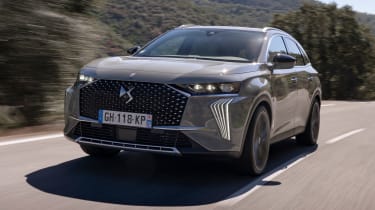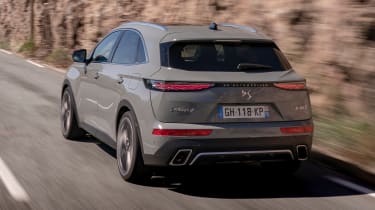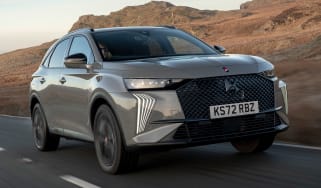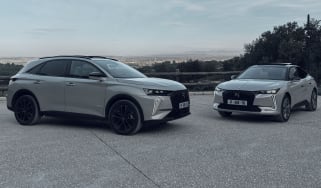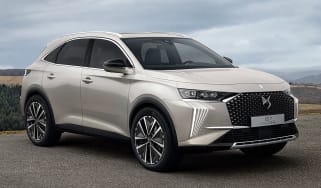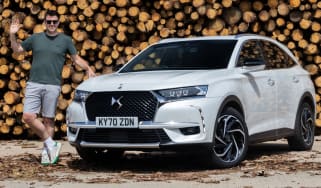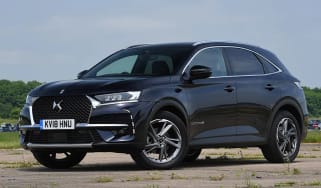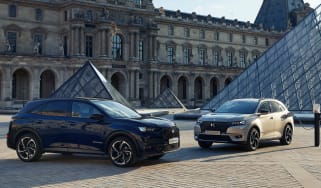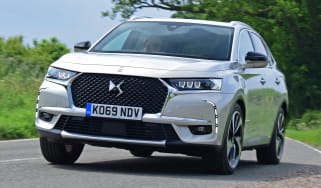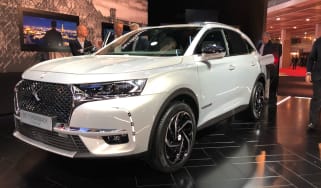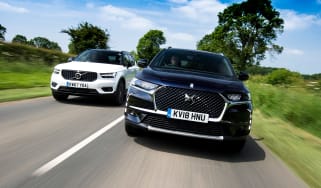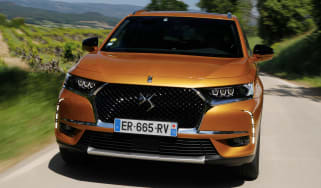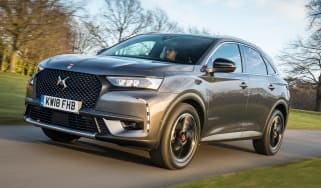DS 7 review
The DS 7 SUV offers a touch of French luxury to take on its established German rivals

The DS 7 competes in a market sector that’s chock-full of talented rivals, but it doesn’t boast class leading qualities in enough areas to be considered a serious contender. It’s an interesting car with a well-appointed, classy interior and plenty of eye-catching features. If you’re looking for a mid-size SUV that’s out of the ordinary and feels special inside, this could be it.
It’s spacious too, but it doesn’t drive anywhere near as sharply as many rivals. The inconsistent ride also means it fails to fulfil its brief as a supremely comfortable French cruiser. Ambitious asking prices mean that there’s no real financial advantage in picking the DS 7 over the alternatives from the premium SUV establishment, either.
About the DS 7
The DS 7 is a roomy mid-size SUV aimed at the upper end of the market. It focuses on offering something different from the norm and largely succeeds. DS, the Stellantis Group premium brand, would tell you that its product delivers ‘French luxury’ in a class where most adopt the more clinical approach typified by the German offerings.
The DS 7 sits above the DS 3 and DS 4 in the manufacturer’s model line-up but it’s not a giant leap up in size from those cars. It uses a version of the Stellantis EMP2 platform that underpins the DS 4 and is shared with the likes of Peugeot’s 3008, the Vauxhall Grandland and the Citroen C5 Aircross. Key rivals for the DS 7, given its premium positioning and pricing, include cars like the Volvo XC40, Jaguar E-Pace, BMW X1 and Audi Q3. Although it is a little larger than these models.
More reviews
Car group tests
Long-term tests
Road tests
- New DS 7 E-Tense 360 4x4 2023 review
- New DS 7 Crossback E-Tense 2020 review
- DS 7 Crossback Ultra Prestige petrol review
- New DS 7 Crossback 2018 review
Used car tests
The DS 7 was on the receiving end of a far-reaching facelift in 2022 that also saw it become the plain-old DS 7 rather than the DS 7 Crossback. The current car is marked out by headlights featuring ‘Pixel LED Vision 3.0’ technology that offers different settings for different road conditions. The striking DS Light Veil daytime running lights extend down from those main light units in the form of five curved lines.
At the back, DS added more body creases for a wider look and slimmer LED lights. Elsewhere, a 12-inch infotainment screen dominates the upgraded cabin in combination with a 12.3-inch digital instrument cluster. The battery pack on the plug-in hybrid models was also expanded from 13.2kWh to 14.2kWh.
The DS 7 has always used its impressive arsenal of technology features to separate itself from the competition. There’s Active Scan Suspension on the plug-in models that ‘reads’ the road ahead and adjusts the dampers to suit, adaptive cruise control that can bring the car to a halt and set it moving again in traffic, plus other kit like a driver monitoring camera, night vision and a head-up display, on some models.
There's a choice of three E-Tense plug-in hybrid petrol engines and a diesel, all using four-cylinder combustion units. The BlueHDi 130 diesel is the cheapest way into a DS 7 by over £7,000 and comes in front-wheel drive form with the EAT8 eight-speed automatic gearbox.
The plug-in hybrids open with the e-Tense 225, another front-wheel drive model with 222bhp. Above that, it’s four-wheel drive all the way with the E-Tense 300 packing 292bhp and the E-Tense 360 which has a punchy 350bhp. That flagship 360 model also comes with suspension changes by DS Performance including upgraded springs and dampers as well as a wider track.
These days there are five trim levels for DS 7 buyers to mull over. Sporty Performance Line and Performance Line + variants lead into the more luxurious Rivoli, Opera and La Premiere models, the latter only available with the E-Tense 360 powertrain.
Standard kit for the entry-level Performance Line cars includes 19” alloy wheels, keyless entry and start, the DS Iris infotainment system (3D connected navigation, voice recognition and over-the-air updates) and a black Alcantara and vinyl leather interior. The Performance Line+ adds black roof rails outside, parking sensors, a reversing camera, electric heated seats and a heated windscreen for about £2,700, which many will see as a worthwhile upgrade.
With the Rivoli model you get a cabin trimmed in black leather chrome roof rails, massaging front seats and the DS 7’s trademark ‘B.R.M R180 Timepiece’ - a clock that folds out of the dash when you start the car. It’s only about £1,200 more than the Performance Line+.
Opera is a £3,500 jump and only available with the E-Tense powertrains. Here the front seats are ventilated, there’s the DS Drive Assist adaptive cruise control, an electric tailgate, a panoramic sunroof plus two extra USB ports and a wireless charging mat. Finally, the La Premiere trim has the full house of DS 7 features including 21-inch wheels, a 360-degree reversing camera, a Focal Electra stereo upgrade, the Night Vision system and hands free access for the electric tailgate. It’s only offered with the E-Tense 360 engine and it costs a considerable £63,000.
As a brand, DS Automobiles has had a confused and difficult upbringing. Quite rightly, Citroen believes the DS model of 1955 is one of its greatest ever cars (it was built until 1975 and sold more than 1.4m units), so when the French company decided to launch a range of new upmarket models in 2010 it turned to the DS name.
The first DS to launch was the MINI-rivaling Citroen DS3 – a car that was highly desirable (and still is) to fashion-conscious British buyers. The DS3 was followed by the Citroen DS4 and the Citroen DS5 – the latter being an oddball offering rivalling the BMW 3 Series that returned the brand to the days of producing slightly eccentric cars.
In 2014 the DS models were divorced from Citroen, with the French company believing DS could stand on its own two feet as a separate brand. DS Automobiles became the third brand in the PSA Peugeot Citroen Group and was tasked with chasing other premium brands like BMW and Mercedes.
DS thinks its cars and its brand are the automotive equivalent of other high-end French names like Chanel and Hermes, and its ‘French couture’ products offer something different from the German norm. And with that confidence behind them, the Citroen DS3, DS4 and DS5 models became the DS 3, DS 4 and DS 5.
That was phase one of the brand separation – phase two began with the DS 7 Crossback, the first DS that didn’t start life as a Citroen. Now part of the multi-brand Stellantis Group together with its Citroen parent, DS is hoping the latest DS 7 can make some real headway having shed its Crossback suffix.
For an alternative review of the DS 7, visit our sister site carbuyer.co.uk...

